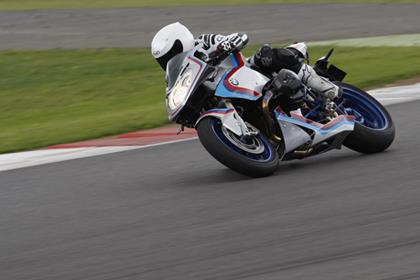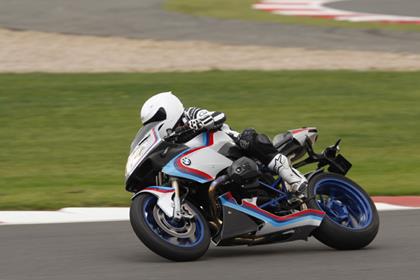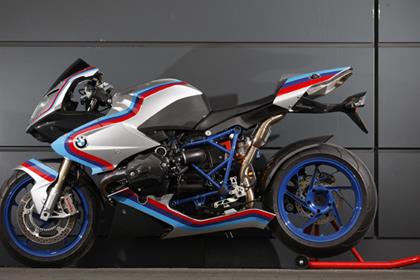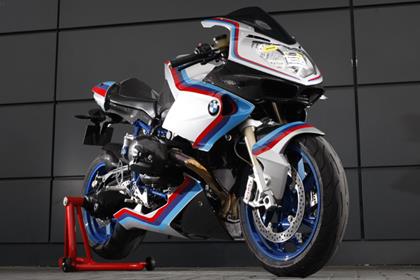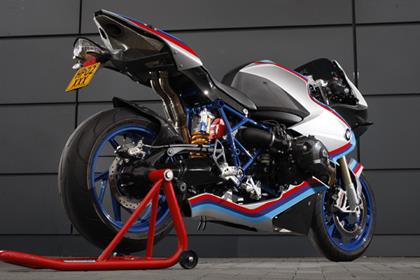The ultimate BMW HP2 Sport
You either love the idea of trying to make a twin-cylinder air-cooled engine that’s based on an old 1923 knocker go like the clappers, or you don’t.
If you don’t, life is simple: you buy a Fireblade or an R1 and go zooming about. If you do you kiss goodbye to normality and sign up to the fringes of mainstream motorcycling, driven by an irrational need to ride a bike that makes its speed the hard way.
In the case of the BMW boxer that speed must come from this 90-year-old design, which, compared to the near-weightless internals of modern superbike engine, reciprocates with the urgency of Stephenson’s Rocket.
Being a BMW that engine must also be mounted in a rolling chassis that is fundamentally designed for touring.
So when in 2007 BMW wheeled out its most daring boxer ever to compete against the 190bhp Japanese superbikes in the World Endurance Championship, it was almost too much for followers of air-cooled BMWs.
The HP2 elevated the old twins to a new level of willful contrariness. It was radical, yes, beautiful too, and dripping in carbon and Öhlins, but still only a pair of heated grips short of an R1200RT.
Touring-style Telelever front suspension and clunky, power-sapping shaft drive were just the start of its quirks.
BMW’s flat twins, so brilliantly configured for air-cooling, also have inherent ground clearance issues that quickly become a limiting factor on track.
And while the 140bhp HP2 had by far the most powerful boxer engine yet seen, it was still 60bhp down on the factory Kawasaki ZX-10s and Suzuki GSX-R1000s — and surely on the giddy limit of reliability. Would it melt?
On paper it was hopeless and exactly how boxer addicts like it. Here was BMW’s most belligerent and maverick statement yet; the ultimate reason not to do the easy thing and buy a four-cylinder liquid-cooled motorcycle.
How could anyone with a heart not support a bike that had more in common with the machinery in the Le Mans campsites than the World Superbike spec bikes it was competing with on the Bugatti circuit?
It got better. The limited edition road going HP2 Sport that followed in 2008 was no watered down look-a-like but an authentic stab at transferring the magic of racer to the road. The front and back ends of the HP2 could be quickly unbolted – it was pure endurance.
There was no conventional rear frame either: the carbon seat unit was the sub-frame and once the exhaust it supported was detached could be removed by undoing just four bolts. The riding position was quickly and minutely adjustable.
Its 189 kilos was a seriously competitive weight; its 120-ish horsepower just enough…
The HP2 Sport was conceived as a £20,000 rival to the Ducati 1098R rather than the £15,200 competitor to the base Ducati it ended up as.
Factory insiders say BMW lost their nerve slightly and down-spec’d at the last minute. Nonetheless, a quick-shifter; one-piece Brembo front brake calipers; Öhlins shocks; carbon bodywork throughout; a new, high revving, double-overhead cam iteration of the opposed twin; ultra adjustability and a data-recording 2D Systems dash made it the most pre-modified sports bike ever seen.
Virtually every conceivable performance enhancing modification had been installed at the factory. Even its carbon cam covers came with nylon sliders.
Its dohc engine, a first for a BMW boxer, would soon be transplanted onto the new R1200GS, but for a year it was boxer exotica — and the best of them all.
It was also unique in the way each camshaft actuated one inlet and one outlet valve, a necessity if the new camshafts were to be chain driven from the crank.
Beautiful skew-ground cam lobes acting on drag levers allowed BMW’s engineers to position the valves radially for a more compact combustion chamber.
Despite making the most power it was the smoothest, most liquid of boxers at high rpm, soaking up abuse as it revved fluently to a lofty 9000rpm.
98 RON petrol was required for optimal performance, though, while, most exotically of all, new con rods were specified at the 30,000-mile service.
Here then is the ultimate air-cooled boxer. As desirable and pointless as a carbon-fibre Spitfire. For those who have one, ownership should bring only rich contentment. Yet there is a problem.
The HP2’s factory-racer specification means there is little that can be done to improve it. The usual list you compile of things you’d like to do and buy to make your bike even better is a short one indeed because there is so little you can do or buy.
A sense of stagnation, that the bike’s development ended the day it left the factory, is compounded by the limited numbers that were built. With just 2260 HP2s out there the market is simply too small for the bolt-on industry to care too much about it.
Luckily nature hates a vacuum. Enter Nigel Wood, a boxer obsessive and former BOAC pilot who once sat on the runway at Entebbe airport with Idi Amin’s soldiers pointing their guns at his VC10.
He has spent his two years of HP2 ownership assessing the bike’s compromises and limiting factors both on road and track, then modifying his bike into what must be the fastest boxer on UK roads.
Nigel hasn’t thrown money at his bike: he has de-quirked it, finished some of BMW’s unfinished bits and borrowed directly from the race project. Perhaps this is what the HP2 would have become if BMW hadn’t turned to the S1000RR.
Quirk 1: shaft-twisting, wheel-locking downshifts
Until the new liquid-cooled GS rocked up, BMW boxers used large-diameter single-plate clutches, which do the job on the road to St Tropez but don’t like abuse.
And they really need to be slipper clutches because on track, or even braking hard into an Alpine hairpin, at least 40 per cent of your attention is spent on timing downshifts and matching revs to avoid shaft-twisting, wheel locking aggro.
Originally made for the endurance racer by Suter Racing, this Fat Cat slipper clutch replacement takes the mechanical pain out of high rpm downshifts, the single worst aspect of hustling a lumpy, high-compression, shaft-twisting boxer.
On track verdict: A slipper clutch contributes massively to the liquid feel of this HP2. Downshifts are unrecognisably smooth and your attention is free to look at the corner ahead. Changing a boxer clutch is a mechanical palaver because the gearbox has to come off but this is what all sporty Beemers need.
Quirk 2: cylinder head digs into tarmac when cornering, lifting front wheel
The HP2 leaves the factory with yards of ground clearance but needs more still on track. Its carries phenomenal corner speed, which quickly becomes limited by scraping cam covers – especially where there is prominent kerbing.
One option is to lengthen the rear Öhlins but that means removing it first (not ideal on a track day); another is to adjust the spring preload but that means knuckle-grazing, collar-chewing c-spanners. Too much bother.
Nigel Wood’s modified HP2 cleverly marries a remote Gubellini hydraulic adjuster to the Öhlins shock, allowing ride height adjustment to be made without recourse to a C-spanner. The concept is no different to remote adjuster on the old R1100S but looks a million times better and dials in more or less ride height in seconds.
On track verdict: the modified HP2 has no ground clearance issues whereas the stock bike touches down under moderately hard track riding. You can adjust it of course but human nature dictates that you probably wont. With this mod the ride height can quickly be returned to normal for the ride home too.
Quirk 3: air-cooled engine trapped within the law…
Noisy, dirty old engines are these days to be stifled, muffled and catalyzed by law. They need to be set free.
The front part of this bike’s exhaust was handmade to order by Don de Vink of Dutch specialists GD Exhaust Performance (de Vink was involved in the development of the endurance bike’s Akrapovic system).
It dispenses with the catalytic convertor, saving three kilos and runs tight along the centre line of the bike, mass centralising as it goes.
The rear section and angular silencer were made to Nigel’s design by JC Weldfab of Wellingborough, a young company that specializes in fabrication work for car racing teams.
‘We split the exhaust’s single pipe into a twin pipe ahead of the silencer box to help deaden the sound,” says JC’s Jon Crossland. ‘Otherwise it would be too loud. It’s okay for trackdays.’
The stock HP2 left the factory with erratic, overly lean fuelling and feels rough at certain revs and loads. Nigel installed a RapidBike Evo system with an auto-tune facility and did 101 runs on the dyno before he was happy. His engine now makes 127.7bhp at the rear wheel, a gain of 12bhp.
On track verdict: Fuelling is smooth and meaty with more midrange punch: this bike is now only 12bhp shy of the factory racer. The noise is like an Lancaster bomber running on two engines and shaping to ditch in the North Sea. An explosive bang on the quickshift upshift distracts fellow trackday users.
Quirk 4: worst mirrors in the universe
Paranoia rides with the HP2 Sport owner. All he sees is blurred elbows and a NIP landing on the doormat.
But here, specially CNC’d brackets attach to BMW S1000R’s excellent long-stemmed mirrors, thus “retaining the factory look” while fitting the HP2’s existing drillings with no hacking of the carbon fairing necessary. Suddenly the HP2 has a rear view.
On road verdict: Mirror extensions make this HP2 Sport faster than any new fuel map. They’re lighter and larger than the stock ones too.
For more details of Nigel’s bits and how to up-spec an HP2 Sport visit www.sandbarcomposites.co.uk
